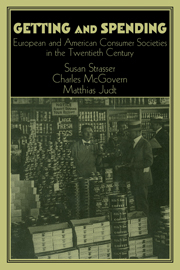Book contents
- Frontmatter
- Introduction
- Part One Politics, Markets, and the State
- 1 The Consumers' White Label Campaign of the National Consumers' League, 1898-1918
- 2 Consumption and Citizenship in the United States, 1900-1940
- 3 Changing Consumption Regimes in Europe, 1930-1970: Comparative Perspectives on the Distribution Problem
- 4 Customer Research as Public Relations: General Motors in the 1930s
- 5 The New Deal State and the Making of Citizen Consumers
- 6 Consumer Spending as State Project: Yesterday's Solutions and Today's Problems
- 7 The Emigré as Celebrant of American Consumer Culture: George Katona and Ernest Dichter
- 8 Dissolution of the “Dictatorship over Needs”?: Consumer Behavior and Economic Reform in East Germany in the 1960s
- Part Two Everyday Life
- Part Three History and Theory
- Index
2 - Consumption and Citizenship in the United States, 1900-1940
Published online by Cambridge University Press: 05 January 2013
- Frontmatter
- Introduction
- Part One Politics, Markets, and the State
- 1 The Consumers' White Label Campaign of the National Consumers' League, 1898-1918
- 2 Consumption and Citizenship in the United States, 1900-1940
- 3 Changing Consumption Regimes in Europe, 1930-1970: Comparative Perspectives on the Distribution Problem
- 4 Customer Research as Public Relations: General Motors in the 1930s
- 5 The New Deal State and the Making of Citizen Consumers
- 6 Consumer Spending as State Project: Yesterday's Solutions and Today's Problems
- 7 The Emigré as Celebrant of American Consumer Culture: George Katona and Ernest Dichter
- 8 Dissolution of the “Dictatorship over Needs”?: Consumer Behavior and Economic Reform in East Germany in the 1960s
- Part Two Everyday Life
- Part Three History and Theory
- Index
Summary
During the Great Depression and New Deal consumption, citizenship, and democracy came to public light in an urgent way. The crisis and apparent near collapse of capitalism generated upheavals in politics that the election of Franklin Roosevelt in 1932 went only partway toward resolving. Such issues as the cost of living, prices, shortages of goods, substitutions, quality of foods, conditions under which goods were made or sold, and safety had for many years lent a political cast to aspects of consumption. Yet only during the New Deal's long-term groping toward political and economic solutions to the depression did the concerns of consumption and consumers become established as a permanent part of public discourse. With protracted battling over policy and with cultural conflicts fostered by economic and social realities, American people fitfully but firmly came to equate the consumer with the citizen, a consumer standard of living with democracy, and the full participation in such an economy of spending and accumulation with being an American.
The association of consumption and citizenship certainly was not new to political thought or even to the United States, but the advent of a consumer society in American in the half century before the depression laid the foundations for this acceptance. By 1930, the vast majority of Americans participated in the industrial economy for getting and spending their daily living, although the implications of that fact for government, culture, or social life were not fully clear.
- Type
- Chapter
- Information
- Getting and SpendingEuropean and American Consumer Societies in the Twentieth Century, pp. 37 - 58Publisher: Cambridge University PressPrint publication year: 1998
- 31
- Cited by

